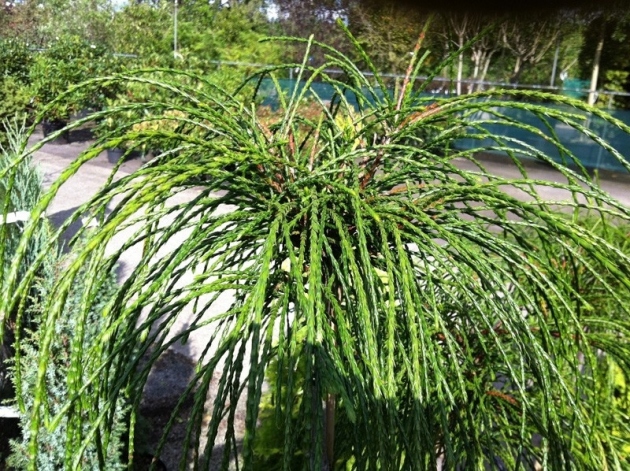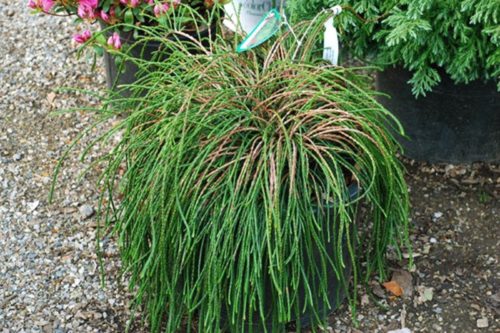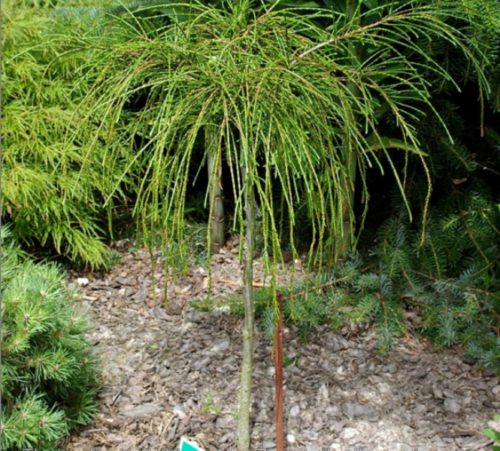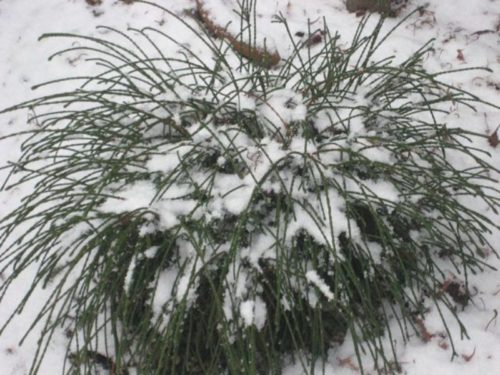Thuja is one of the most sought-after coniferous crops, which are used in modern landscape-design arts. Slender evergreen beauties decorate parks, squares, urban recreation facilities, country estates and summer cottages. Tyu is often used as an original pot culture for decorating a home or office interior. Thuja belongs to the family of cypress and there are about 100 decorative forms that can be raised at home. One of these decorative varieties is Thuja Vipcord. This is a kind of folded thuja with a height of up to 1 meter and an incredibly beautiful shape of the crown. The shoots of Tui Vipcord are lower, filamentary, falling to the ground, resemble green ropes. Translated from the English "WHIPCORD" - "Rope", "BACHEK", "KNUT", from here and the original name of the variety.
Tuya Vipcord: Description
Thuja "Whipcord" - dwarf variety of folded thuja. This is a shrub, not more than 1 meter high, with an unusual shape of the crown. For a variety, poor, long and thin, not branching shoots. Chesewood needles, brilliant, tight pressed to the shoots. The ends of the filamentous shoots are sharp and sticking. In the summer, the needles has a green color, and a fabulous bronze tint is acquiring frosty in winter. The shrub is growing slowly, 10 years after landing, it reaches a height of up to 30 cm, and in width - up to 60 cm. The frost-resistant variety is not afraid of strong winds, it has been growing successfully at any illumination and unpretentious in care.
Thuja Vipcord: landing and care in open soil
- For the cultivation of the WHIPCORD variety, fragrant, fertile, loose soils with good moisture permeability are suitable. In the dry poor soil, the shrub will reluctantly and slowly grow, and the crown is to be rare.
- The landing of the Tui seedling is produced in spring, it can be purchased in a nursery where decorative coniferous cultures are grown for sale. Buying seedlings, look at the root seedling system, it must be closed (located in a container or wrapping bag). With cereal roots, when landing in a new place, the car's seedling may not take care and die.
- A place in the garden for a coniferous shrub will suit any, thuja perfectly gets along in a half, and in the garden shadow. The only condition, a straight sunshine should not fall on a quiet. The landing pit must be 2 times the root seedlock. Locking a seedling of coniferous shrub into the landing pit, you need to ensure that the root neck is on the same level with the soil. If this important landing condition is non-compliance, the root plant of the plant can be contrary.
The care of the Thuy is simple. In order for an unpretentious decorative shrub to have a healthy look, you must follow the following rules:
- Watering. The drying of the soil is detrimental for Tui Vipcord. It should be constantly monitoring the humidity of the soil and not to allow it to dry. Watering young landings are necessary once a week, in the morning or evening, after sunset. First month after landing, make the crown irrigation. Sprinkle will navigate to moisture, it mocks dust and improves oxygen access. Adult trees are quite abundant watering every 7-10 days (up to 15 liters of water under the bush). In rainy weather, coniferous shrub can not be water.
- Protection against pests and diseases. The needle of the thuu is most often attacked by the Tly, which are settled at the ends of its drooping shoots thanks to the ants. Rapidly multiplying, the TLL creates numerous colonies that feed on a gentle juice of young shoots. If you do not fight with tool, shoots stop your growth, dry, losing your attractiveness. Insecticides (actar, phytodeterm) are used to combat aphids. In addition to the twee, you can attack the shields, turbo loudes and other pest insects, for prevention you can spray fufanon.
- Tuii diseases It is rare, mostly, these are fungal diseases caused by improper care or non-compliance with the rules for planting a coniferous shrub. Fungicides are used to combat fungus (carboophos, topxin, phytoosporin).
- Sanitary trimming. In the spring, all damaged and dried tui wipcord shoots should be removed.
- Reproduction. Thuja seeds, stalling and tanks breed. The process of reproduction is laborious and long. The process of growing the Tui from seeds can take up to 6 years! Therefore, it is rarely used by dacnis.
- Wintering. Thuja Vipcord is a frost-resistant decorative grade, which is not afraid of a strong wind, but harsh weather conditions, below 8 degrees of frost, can lead to the extinction of the needles. To protect the bush from severe frosts, it is insulated using underfloor material. If you are soft in your winter, you can not cover.
- Spring subcord. After the melting of snow, it is necessary to feed the fertilizer with nitrogen and phosphorus.
How to grow a sharp vipcord in a container at home
Thuja Vipcord is a dwarf decorative grade, which is successfully grown in the container. Landing container should be spacious. In the first years of his life, it is replanted annually into a new pot, increasing its diameter for several centimeters. To the coniferous beauty adorns your home for many years, you should correctly fulfill all the conditions for its landing:
- Choosing a pot, pay attention to the root system of the plant. Capacity for landing should be 3 times the root. At the bottom of the pot must be drainage holes, so that the excess moisture quickly leave and did not harm the root. As a drainage, the bark is suitable, ceramzit, foam.
- Soil for growing Tui should be loose, nutritious and fertile. You can purchase a special soil for coniferous crops, enriched with all the necessary minerals to grow the car. You can also prepare the soil alone from sheet, conifer, turf and sand, observing the ratio 4: 2: 1.
- Sedna landing Tui Vipcord into the container, no different from landing in the garden, the main thing is to properly place the root neck in the container, heavily from the ground. After landing, it's good to moisten the soil and put the pot into a bright place in the house so that the bush does not hit the straight sun rays.
How to care for Tuya Vipcord in a container?
Thuja Vickord is unpretentious in care, it is enough not to forget to water the plant and transplant in time:
- Temperature mode. The optimal temperature for coniferous culture grown at home, 18-24 degrees. In winter, during the heating of the house with heating devices, a coniferous shrub container should be transferred away from the heat source, and it is better to transfer to a glazed balcony or loggia.
- Lighting. The best place in the house for the cultivation of Tui in the pot is the northern or western windows with shading. Tender needles do not transfer direct sunlights to it, which can lead to a burn.
- Watering. Watering the coniferous shrub is recommended 1-2 times a week using dilated water. Do not allow drought or smear moistening.
- Podchar. You can finish with a special complex fertilizer for coniferous crops, twice a month. In the summer period, Thua needs potash feeding, in spring - in nitrogen-containing fertilizers. In winter, the soil does not fertilize.
- Transfer. The important condition for the good growth of the coniferous shrub in the pot is an annual transplant of a young plant in a potty-larger pot with a replacement of fresh soil.
Tuya Vipcord in Landscape Design
Thuja folded Vipcord is a real wonder of any garden, which decorates any plot with its touching wrecks. The flooded bushes look beautiful in a single landing on the lawn, near the reservoir, and also perfectly complement other plants when creating a landscape composition. The plant is used in mixlers, alpine rols, mountaineers, rockers. With the help of an attractive evergreen Tui you can decorate a place of rest in the garden, which will exude a tart and pleasant aroma of needles.
Decorative shrub is often used for growing in a container or pot at home. It is enough to give bushes a certain form, periodically cutting shoots. Growing decorative vipcord in the pot at home, your dwelling will be filled with a coniferous aroma, and the unusual view of green hanging shoots cause admiration for households.



















 Start a discussion ...
Start a discussion ...